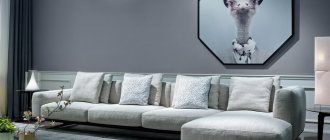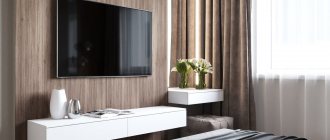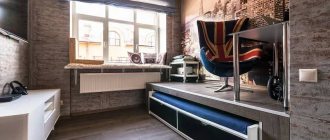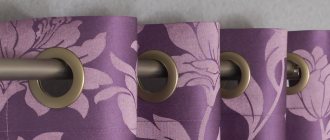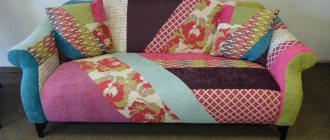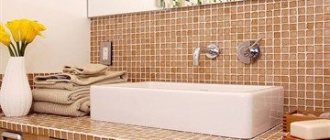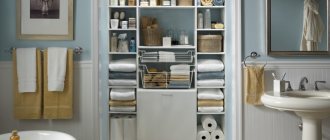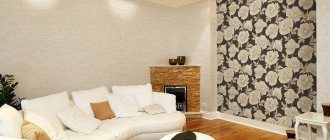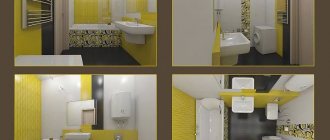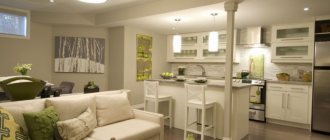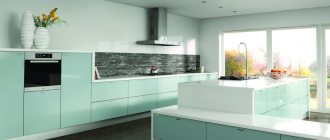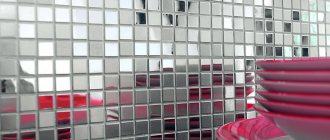Patchwork, or patchwork, is a patchwork sewing technique that has gained great popularity since ancient times, as it made it possible to create voluminous items of an unusual appearance from small scraps of fabric. Large blankets, capes, pillowcases, and bedspreads were sewn using this technique. Nowadays, in order to achieve a patchwork effect, they use not scraps, but textile decor that imitates patchwork. As a rule, interiors in “retro” or “country” style are decorated with this decor.
Modern technologies have made it possible to transfer patchwork patterns to ceramics, and now they decorate not only fabrics, but also walls and floors using patchwork tiles. It has a variety of patterns that are digitally printed and can be either two-color or multi-color.
Patterns are applied to both regular ceramic and porcelain tiles. By combining different patterns, you can achieve an original effect reminiscent of pictures from a kaleidoscope. Quite often you can find specially selected sets on sale - they have the same size and different patterns.
Finishing features
Patchwork style finishing material is created using new technologies. Designs combining patterns of different shades are transferred to blocks using digital printing. Porcelain stoneware or ceramic products are used for cladding.
The slabs are offered by manufacturers as a set or selected for finishing different rooms. With the help of slabs, wall panels and decorative elements are created, floor and wall surfaces are laid out.
A wide range of textures and shades of finishing materials allows the blocks to be used in different style solutions.
To create an original design, you must take into account the rules of combination:
- fragments are laid on the surfaces of the premises according to a single pattern to create a harmonious design;
- parts of the composition must be consistent in the general color scheme and in the same style;
- interior colors should be repeated in tile patterns;
- elements of the placed composition must be of appropriate thickness and suitable dimensions;
- The technique of applying the image and the processing of the edge must be the same;
The design of patchwork blocks should complement the layout of the room.
Don't forget about the little things
Even if you decorate your kitchen with a huge wicker panel covering an entire wall, the true manifestation of the patchwork style is reflected in the small details.
Think about what items you would like to place additional emphasis on: they should resonate with the main element, as if emphasizing and shading it.
Don’t be afraid to use handmade ones - it will add uniqueness to the room, which is so valued by lovers of this technology.
What can we say in conclusion? Patchwork is a unique stylistic addition that will help create an atmosphere of warmth and comfort in the kitchen. But you need to be very careful with it - no overdoing it, otherwise the effect will be exactly the opposite.
Personally, we would recommend it to those who like bright things “with history.” But for lovers of more classic interiors, we advise you to look at the special section of our website.
Ceramic tiles in patchwork style: art in the interior
Patchwork tiles for the bathroom are designed to create an original design of walls, floors, and accent inserts in the interior. When decorating panels with decorative elements with patterns, designers recommend choosing furniture, accessories, and textiles that are monochromatic and restrained in color.
In the background finish for slabs, the optimal basic color palette is:
- beige;
- light gray;
- white;
- blue;
- olive.
An original tile finish on the surface of the bathroom floor with monochrome walls in light colors or a wall in the shower with a composition of slabs with patterns.
An artistic panel made from patchwork blocks can become an accent part of the bathroom interior.
When decorating the floor surface, it is possible to lay “patchwork rugs” on the floor to outline functional areas next to the shower stall, at the sink, or at the entrance to a spacious room.
Compositions of ornaments are emphasized by slabs with smooth matte or glossy surfaces.
Styling tips
Before installing the apron, markings are made. Using chalk, silhouettes of furniture modules are applied to the walls so that each of them takes its place. After this, lines of the edges of the cladding are drawn on the wall. A metal profile or wooden beam is attached to the lower border.
The tile adhesive is applied in a thick layer and then leveled using a notched trowel. After placing each row of tiles, check the clarity of the line using a building level. After finishing the cladding, inspect the surface of the apron for the presence of glue. If contamination is detected, the stained areas of the ceramic are immediately cleaned.
Tile combinations
When composing combinations of elements, it is necessary to select slabs with similar parameters based on the type of edge, thickness, and technique for processing the external surface. It is important to maintain the combination in geometry and shade range.
It is optimal to use slabs with monochrome patterns, combining 2-3 shades.
Manufacturers offer ready-made collections of blocks with combinations of elements of different patterns and sizes, designed in a single color scheme.
When selecting individual elements, it is necessary to take into account the match in style, color or geometry.
Small or large fragments
When choosing the sizes of decorative slabs, it is necessary to take into account the dimensions of the room for finishing. In small bathrooms, it is optimal to use compact blocks - 10x10, 20x20 cm.
When using large slabs, the compact space will visually narrow. In rooms from 6 m² you can use medium-sized slabs.
In spacious bathrooms in private homes, you can decorate with large-format decorative elements simulating several small patterned slabs.
Apron
The backsplash is the first and foremost place to use Patchwork to add personality to your kitchen. It plays not so much an aesthetic, but primarily a practical role in the kitchen, keeping the work area clean.
Patch tiles essentially give you creative freedom and add color and pattern to a room in abundance, but you don't have to be limited to just the traditional design approach of using the standard 5-6 patterns.
Any style will do, from eclectic to sophisticated, from monochrome to a stunning Mediterranean that has irrepressible vitality. Each composition should be full of uniqueness, expressiveness and intrigue.
Rustic style
Stylistic compositions
Boards with designer finishes and multi-color combinations are suitable for different styles.
However, it is important to select the appropriate color scheme of elements and type of patterns.
The products are widely used in the following areas:
- country;
- Provence;
- classic;
- minimalism;
- Scandinavian;
- retro, etc.
Minimalist interiors are decorated with patchwork blocks in neutral colors (light gray, beige) and a combination of pastel colors. Ceramic blocks with graphic patterns will allow you to create accent areas and visually expand the room.
The main decoration of the interior will be the patterns on the blocks. The elements are arranged randomly or using collage techniques.
It is necessary to match the color scheme of the walls, floors and patchwork slab inserts.
Organically bright slabs look great in a country style interior. When finishing, monochrome combinations of rich tones (brick, terracotta, orange, green) or with patterns of different shades are used.
It is necessary to create smooth transitions of multi-color and neutral colors in the decoration of the room.
Ceramic products using the patchwork technique are common in the decoration of premises in the Provencal style. The room will be decorated with slabs in pastel colors with floral or graphic patterns; it is possible to include stripes on the blocks.
For the style direction, slabs with the effect of brushing, aging of the surface, and imitation of decoupage on blocks are organic.
Retro-style rooms are complemented by multi-colored slabs in bright colors. Warm rich shades (burgundy and beige, brown and green) are optimal. It is necessary to complement the surface with slabs with the effects of scuffs, chips, or patterns that have faded over time.
The elements will allow you to recreate an imitation of the historical interior setting using ornaments from different eras.
In a classic room, tiles with geometric patterns can be used. The color scheme should be neutral (blue, white, dark brown, white, light gray, sand).
Combinations of dark gray and muted green, golden and milky are popular. The elements can use a cage or strip.
Mediterranean-style spaces use patchwork blocks with a combination of white and navy blue. Combinations will visually expand the room and create an original accent on wall panels and floor surfaces. Light green, milky, and light yellow shades look harmonious in a Mediterranean interior.
Patchwork slabs can be decorated with thin stripes, checkered patterns, and geometric patterns on a light background.
In Scandinavian interiors, it is optimal to use products in light colors with geometric patterns; it is possible to include colored elements against a background of beige and milky shades.
Decorative slabs can be combined with solid wood elements or complemented with wood furniture.
Color solutions
For the patchwork style, the choice of color combinations is especially important.
The following color options are available for this tile:
- Monochrome. For example, black and white, gray and white, beige and brown. Using this option, you don’t have to be afraid to make the interior overloaded. Monochrome ornaments look openwork and airy.
- Two or three colors. For example, blue and white or black and yellow. Beautiful, playful combinations should still be used more carefully. Their excess can lead to ripples in the eyes. Therefore, they should be used pointwise, just to emphasize something.
- Multicolor. Each tile can be made in its own color. For example, there are collections that combine red, blue, yellow, white and orange. This bright option is suitable for the calm interior of a white kitchen or bathroom. This is a bold decision, it looks like a kaleidoscope, so calm people may be tired or irritated. On the contrary, for creative, cheerful people, such a style solution will be perceived harmoniously and comfortably.
The peculiarity of the variegated colors of patchwork tiles in interior design, especially multicolored ones, is that in large quantities they can “break” the proportions and geometry of the room. It introduces a certain dynamics and dominates the space. To avoid overdoing it, tiles should be combined with classic monochromatic options, adhering to the rule “less is more.”
Wall tiles
Elements using the patchwork technique are used to decorate wall panels. The slabs are lightweight for easy installation. The products are not designed for heavy loads, are decorative, and are available in different textures.
Wall elements are placed to accentuate the shower area, at the sink, or as a horizontal strip above the bathtub.
Surfaces must be resistant to humidity, frequent cleaning, and chemicals.
Floor mosaic
Patchwork mosaic for the floor must be wear-resistant, designed for heavy loads, and resistant to chemical detergents. The color range of products is standard and must correspond to the uniform style of decoration of the room.
For long-term operation, it is important to consider the thickness and dimensions. Floor elements are available in large sizes for easy installation.
It is necessary to take into account the low thermal conductivity of coatings and install a “warm floor” system.
When selecting materials for floor finishing, experts advise choosing durable porcelain stoneware blocks. The products are evenly tinted and more durable under constant mechanical stress.
In ceramic products, paint is applied to the surface; the slab is not painted in bulk and loses color intensity over time. Porcelain stoneware blocks are distinguished by their heavy weight and resistance to damage under loads.
You can tile the entire floor surface in the bathroom or create a long strip at the edge. The creation of accent inserts at the sink or shower with imitation carpet looks original.
Patchwork tile manufacturers
Manufacturers of ceramic and porcelain tiles include products using the patchwork technique in their collections. Ready-made sets of blocks are offered, differing in size or design. For flooring, large blocks of porcelain stoneware are offered with an imitation layout of 4-8 mosaic patchwork elements.
The products market includes products from Italian manufacturers (Ragno Marazzi, BayKer), Spanish materials from the La Platera, Roca, Mainzu brands.
The following companies are also included in the ranking of popular products:
- Cersanit (Poland);
- Kerama Marazzi (Russia);
- Lasselsberger Ceramics (Austria).
Products from domestic manufacturer Kerama Marazzi
It is distinguished by its affordable price, versatility, and the presence of a wide range of sizes and shades of slabs for various purposes. Products are manufactured in accordance with European standards.
In addition to ceramic blocks, the manufacturer’s product line includes high-quality porcelain stoneware products.
Italian company Italion
Produces decorative tiles, porcelain stoneware blocks for finishing bathrooms and showers. The company develops finishing materials for walls and floors and offers a wide range of patchwork bathroom tiles.
The products are of high quality, with a rich palette of colors and patterns.
Polish company Cersanit
It produces complex products for finishing bathrooms. The company offers collections of patchwork products, for which you can select finishing materials taking into account style and workmanship.
The products are high quality, wear-resistant, durable.
Dual Gres Company
Supplies porcelain slabs with elegant designs in different styles. The products are strong, durable and high quality.
Products are manufactured in accordance with European standards and undergo quality testing.
Material classification
An important property of the finishing material is abrasion resistance. There are several types of coatings in the range of porcelain tiles. They differ in the ratio of components that provide functional indicators that determine the purpose of the products. In the category of porcelain tiles there are 5 classes, the material is selected depending on the degree of load:
- low – grades 1 and 2;
- secondary – 3rd grade;
- high – 4th grade;
- advanced – 5th grade.
Porcelain tiles for the kitchen are selected depending on the degree of load
Class 4 and 5 tiles are used in the design of public facilities and industrial buildings. These materials can withstand the loads of a large flow of people and vehicles. If you need to clad walls, coatings of classes 1 and 2 will be the best choice. Porcelain tiles for kitchen floors should have higher strength and abrasion resistance. An excellent option for such finishing is class 3 material.
Porcelain tiles for kitchen floors must have high strength
Photo gallery of patchwork style tiles
To decorate a bathroom and toilet with slabs with graphic patterns, the following are used:
- inserts;
- interior accents.
Inclusions of decorative elements are used in the decoration of floors and walls. It is important to take into account the color scheme of the room; the most effective use of slabs with patterns on a monochrome surface.
Elements included in a monochromatic masonry may differ in dimensions and patterns, while maintaining the same style and color.
Insertions are made using plates:
- plain with pattern;
- monochrome with ornaments in different techniques;
- multicolor;
- multi-colored slabs with combinations of lines and patterns.
Interior accents serve to visually highlight a piece of furniture (table, sink) or part of a continuous surface.
Experts suggest tiling part of the bathroom, the walls of the shower stall, the space above the sink or the surface of the table.
A narrow line with blocks of floral or graphic patterns will visually lengthen the space of a small bathroom.
Accent areas can be the surfaces of arches and columns in a spacious bathroom.
An original interior accent is the placement of carpet-shaped blocks in the center of the room, simulating suitable techniques (“checkerboard”, “diagonal”).
Plates with aged effects and muted shades look original in different types of interiors.
Products with the effects of brushing and decoupage of surfaces look stylish in rooms complemented with forged interior items (bookcases, chairs, stands) and furniture made of natural wood.
Let's try to combine
To be honest, the idea of decorating the entire room in this style does not seem very successful to us: the result will be too colorful and will tire the eyes. But making it an accent is a great solution.
It would be logical to assume that such flashy decor is not appropriate everywhere - for example, it is difficult to imagine it in a classic kitchen or, conversely, in a high-tech room.
But for Provence, country, Scandinavian or Mediterranean design, this is what you need.
The patchwork style looks no less impressive in the interiors of kitchens made in the shabby chic or boho traditions - wherever bright colors and ethnic patterns are welcome.
But in general, you can always experiment - probably a good specialist will help you develop a design project with a successful combination of this style and loft. The main thing is to imagine how such a combination will look in real life, so that later you don’t have to hastily redo the renovation.
To do this, you need to understand all the nuances well. Let's get started?
Examples in the interior
DO YOU HAVE ANY QUESTIONS?
Ask a specialist
